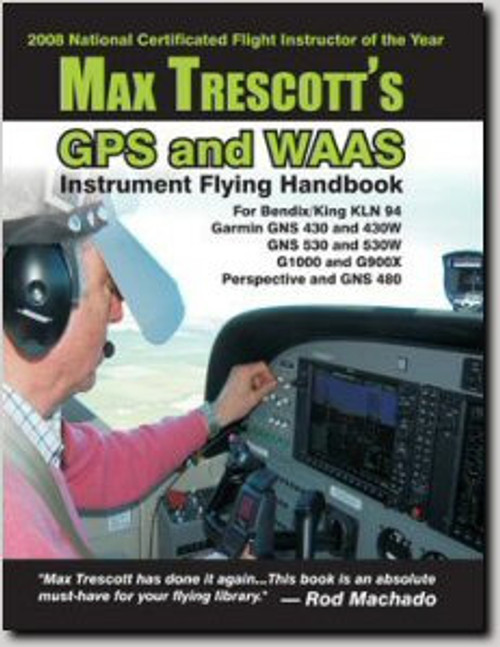New, comprehensive guide to using popular Garmin & Bendix/King GPSs. "Max Trescott has done it again…This book is an absolute must-have for your flying library" -Rod Machado
Don't get stuck in the clouds wondering which button to push!
New! Get the one book that tells pilots what they need to know to safely fly using a modern GPS receiver and autopilot. Most books treat GPS as a subtopic and don't tell everything you need to know about using GPS. Max Trescott's GPS and WAAS Instrument Flying Handbook recognizes that GPS is at the center of modern cockpits and not just add-on equipment. Designed for both VFR and IFR pilots, this book tells you what you need to know to safely operate modern GPS systems including detailed, step-by-step instructions for the Bendix/King KLN 94, Garmin GNS 430, 430W, 480, 530, 530W and G900X, G1000 and Perspective glass cockpits.
Modern technology is rapidly changing the avionics used in new Beechcraft, Cessna, Cirrus, Diamond, Mooney, Pilatus, Piper, TBM and other General Aviation aircraft. However the complexity of GA cockpits has increased to the point where pilots now need separate GPS and autopilot training. Operating the equipment is not intuitive and safety dictates that pilots understand how to get the most out of a modern GPS receiver.
Max Trescott's latest book takes the reader through the details of how GPS and WAAS, the Wide Area Augmentation System, operate. Then he gives detailed instructions for operating the most popular panel mounted GPS. He explores common misconceptions such as the myth of "activating the approach" and why you never need to do it. He also explains the new WAAS minimums: LPV, LNAV/VNAV, LNAV, LNAV+V, and LP and why checking RAIM no longer matters with a WAAS-capable GPS receiver.
Experienced pilots may be surprised to learn why you should always load an approach with an IAF-even when receiving vectors to final. They'll also learn why what they used to do with the SUSP key will now get them in trouble when loading an instrument approach.
Throughout the book, NTSB reports and NASA Aviation Safety Reporting System pilot reports are used to illustrate pitfalls in using-and misusing-GPS equipment. Dozens of practical GPS and IFR tips, gleaned from the industry's most experienced flight instructors are clearly displayed in the margins. Serious pilots who want to understand all of the intricacies of using their GPS and autopilot while avoiding common "gotchas" will want a copy of Max Trescott's GPS and WAAS Instrument Flying Handbook.
Learn What All Pilots Should Know The big differences between the Direct-to key and using a flight plan.
Getting started entering flight plans.
Learn the Right Way to Load Approaches including:
The myth of needing to "activate the approach".
Why you'll never want to load an approach with an IAF-even when receiving vectors to final.
When to Load versus to Activate an instrument approach.
Why pushing the SUSP key gets you in trouble when loading an instrument approach.
Learn About Flying Instrument Approaches
How to fly ALL instrument approach types.
Why checking RAIM alone isn't sufficient with a WAAS-capable GPS receiver.
How to use your autopilot along every step of the approach.
Why your autopilot may fail to couple to an ILS glide slope.
Why some missed approaches begin before a GPS counts down to zero.
Learn About WAAS and other New Capabilities
Details on new minimums: LPV, LNAV/VNAV, LNAV, LNAV+V, and LP.
How to tell if a GPS is certified to use new WAAS-based approaches.
Different regulations that apply to WAAS-based GPS receivers.
Loading airways and flying GPS-based T- and Q-route airways.

















